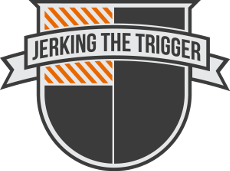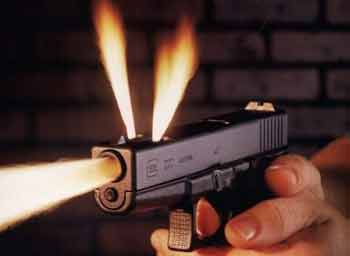I recently received an question from a reader regarding why there hasn’t been more acceptance of ported or compensated handguns while comps and brakes have been enjoying increasingly wide spread acceptance on long guns. I thought it was a pretty interesting question that was worth responding to on JTT rather than just via email.
I think the single biggest reason that you don’t see more porting and comps on handguns has to do with the fairly vast differences in how they are utilized. In order for compensation to do the most good, it must be placed relatively close to the muzzle. That means that the ports are usually at least 16 inches or more away from most of your body (not counting the support hand and arm) when a long gun is being used. However, with a handgun, those ports may be just inches from your body if you are shooting from a retention position.
There may be other factors (size, weight, holster considerations) but I suspect that the potential necessity of using a handgun close to your own body is the main reason.
What do you think? Did I miss something obvious? Do you expect to see more compensated handguns in the future?


In my experience, there are two main styles of handgun muzzle compensators: internal (such as the Glock “C” models) and external (competition guns). The latter typically is markedly better at keeping the muzzle down. But: when recoil is properly managed, the linear distance that the muzzle rises does not matter because it returns to the target at the same speed at which it left.
Therefore, the small advantage gained from an internally compensated barrel is not worth the disadvantages.
In external, brake style compensators on a competition guns, however, the gasses strike a surface perpendicular to the bore as opposed to gasses simply jetting vertically through integral slots. The amount of muzzle rise is drastically reduced, but at the cost of relatively extreme side blast and concussion that is inappropriate for a carry gun.
For these reasons, I don’t think we will see an increase in the number of compensated carry guns in the future. In light of the disadvantages, integral compensation does not provide a significant benefit towards decreasing muzzle rise when proper recoil management is employed. A brake that actually does significantly keep the muzzle down is impractical for carry.
Learning proper, real world recoil management techniques is the way to control the muzzle on your carry gun. Those same skills transfer to braked competition guns as well.
Nicely done Kip.
Small slivers are jetted with the gasses–rifle or pistol. I’ve picked them out of my hands, and I hate to think about an ER doc picking them out of my eye.
Duty ammo flash isn’t that dramatic at night, but your view of the scene is extremely important after you turn off the white light.
Comp is a great idea for gaming, sporting, but not for serious use.
Not to mention when most handguns are used in a defensive manner it is indoors. The concussion from a compensated glock is deafening indoors accompanied by a very large flash which makes it not a effective defensive handgun.
How different is a compensated semi auto’s blast, as shown, than a revolver’s cylinder gap blast? Can it really be that much of a big deal in a defensive situation, since revolvers have been used in defensive situations for over a century?
(I’m really asking, no “tone” in text.:))
Good question! First, the old Glock ads were greatly exaggerated so muzzle and port flash is not usually that bad, especially with good SD ammo which is specifically made to be less flashy. Second, revolvers (at least quality revolvers) have extremely narrow flash gaps – much narrower than any port – so it is typically a non-issue. That said, enough hot gas escapes that it will actually cut or groove the top strap of the revolver over time so keep your fingers away from the flash gap!
Someone please correct me if I’m mistaken, but I was also under the impression that a compensator, especially on a short barrel, such as a handgun, can also significantly reduce muzzle velocity which would be undesirable for most defensive applications.
Compensated carry weapons disencourage shooting from retention, and other asymmetrics; in short, they add additional complexity to the safe and effective employment of the weapon system, with only simple benefit.
Not to mention that porting of pistols are only really effective with higher pressure rounds. Like the .38 Super, where the comps really help, for anything else they are hardly effective.
We are issued Glock 22C’s as a duty weapon. I was told they were chosen after a comparison between the regular Glock 22 and the C models where both were shot by several Officers. The scores on the quals were higher (better) for the C models. They were also selected because it was less felt recoil by non experienced shooters and females. I was not employed at the PD at the time these pistols were selected so I don’t know the extent of the “testing”.
Comps reduce recoil – if for no other reason then you are hanging weight off the end of the barrel, even if the pressure is low and comp isn’t that effective. Reduced recoil usually helps with faster shot recovery and less flinching. The solution for the cops with the 22C’s is to shoot 17’s in 9mm+P instead, since real data (not gunwriter fiction) shows that 9 and 40 produce near-identical results.
Pistols in general are quieter than shotguns or rifles, all guns are way over the threshold of pain for human hearing, so noise isn’t an issue pro or con – but burns and fragments coming out the comp are. In all other areas, comp guns provide an advantage which is why competitors use them.
The reason I quit carrying my compensated carry gun was the risk of self-inflicted injury when shooting from retention or any kind of very close quarters situation.